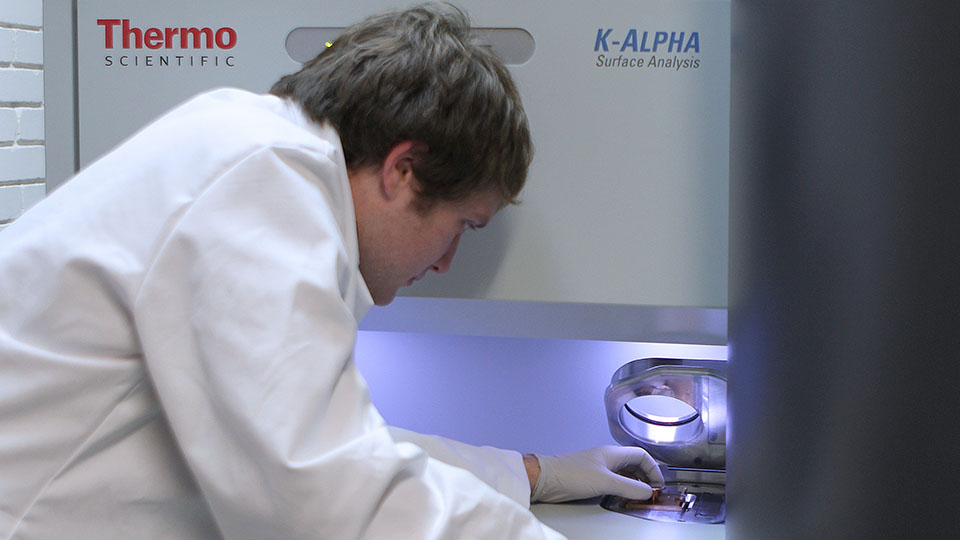X-Ray Photoelectron Spectroscopy (XPS)

LMCC houses a wide range of surface analysis instrumentation. X-ray Photoelectron Spectroscopy (XPS) is one of the instruments within this family.
X-ray Photoelectron Spectroscopy (XPS) is a surface sensitive technique, which analyses the elemental composition of the top 3 – 5 nm of a material by the analysis of photoelectrons that are removed by an X-ray source. It can be used to analyse both powder and solid samples; including metals, ceramics and polymers and is capable of detecting all elements except helium and hydrogen.
Typical industrial uses
- Characterisation of thin films
- Measurement of surface composition in failure analysis and adhesion problems
- Characterisation of the chemistry of surface treatments
- Measurement of silicone transfer rates from release papers or liners
- Functional group identification
- Corrosion/oxidation studies
- Evaluation of surface cleanliness
- Catalyst characterisation
Key Capabilities
- All elements detected from Li to U, except for H and He
- Quantitative
- Chemical state identification
- Suitable for conducting and insulating materials and semi-conductors
- Surface sensitivity from 0.5 to 5 nm
- Detection limits that range from 0.01 to 0.5 atomic %
- Area mapping and line-scans with 40μm resolution
- Sputter depth profiling
- Angle dependent depth profiling
Specification
- Thermo K Alpha
- Al K-alpha x-rays (1486.6eV)
- Ion source operating range 100eV – 3keV
- Flood source for charge neutralisation
- Maximum sample size - 60mm x 60mm
- Maximum sample thickness - 20mm
- Maximum analysis area 400μm x 400μm
- Minimum analysis area 40μm x 40μm
- Tilt range -90° to +90°
- Data analysed using Thermo Avantage software
Sometimes known as Electron Spectroscopy for Chemical Analysis (ESCA), XPS can also provide detailed chemical information about surfaces. The energy of the emitted photoelectrons is dependent on the local chemical environment of the atom. This allows the chemistry of the surface to be inferred and the functional groups present to be identified.
The K-Alpha XPS provides the capability to carry out depth profiling by using an Ar ion beam to etch deeper into the sample. This can produce a multi layered depth profile and provide the ability to measure changes in oxidation states and the composition of elements as a function of depth.
When dealing with uniformed layers, it can be useful to confirm what order the layers are within the material. By tilting the sample, XPS becomes more surface sensitive and changes in the top 1nm can be determined. This technique is known as Angle Resolved XPS or ARXPS.
LMCC currently has a Thermo Scientific K-Alpha X-ray Photoelectron Spectrometer (XPS), details of which can be obtained below:
Thermo Scientific K-Alpha X-ray Photoelectron Spectrometer (XPS)
Key Capabilities:
- Thermo K Alpha
- Al K-alpha x-rays (1486.6eV)
- Ion source operating range 100eV – 3keV
- Flood source for charge neutralisation
- Maximum sample size - 60mm x 60mm
- Maximum sample thickness - 20mm
- Maximum analysis area 400μm x 400μm
- Minimum analysis area 40μm x 40μm
- Tilt range -90° to +90°
- Data analysed using Thermo Avantage software
Upgrades:
- Tilt module for ARXPS
Are you interested in using this technique?
If you are interested in using this technique and would like further information please do not hesitate to get in touch.